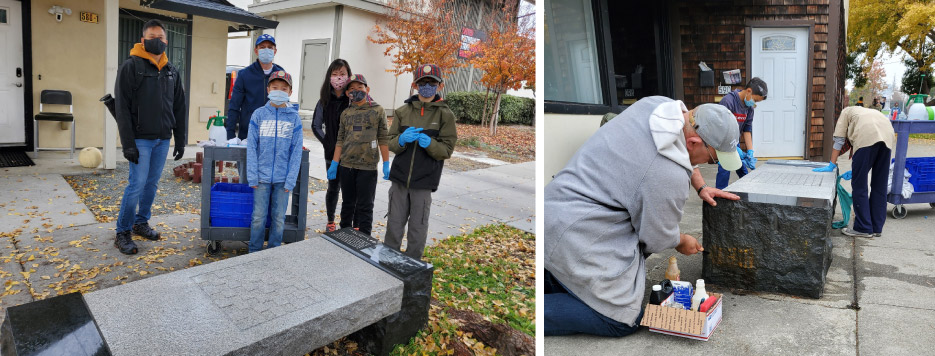From Rock ‘n’ Roll to Rocks
Peter J. Marcucci
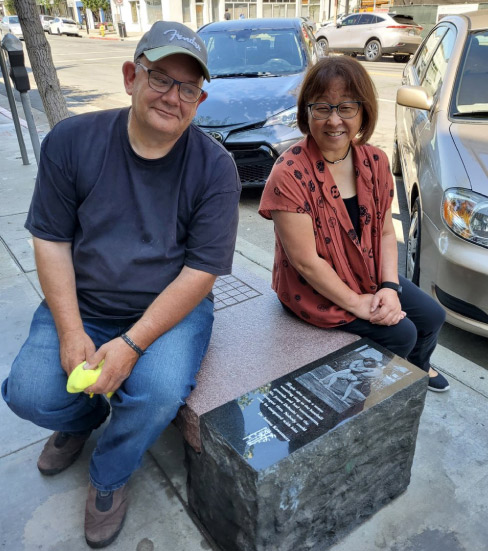 |
|
David Bonasera and Pam Yoshida on a restored granite bench showing the area history of Sumo Wrestling. Yoshida is a production coordinator for a local architectural firm, a member of the Construction Specifications Institute, and is heading up the community response on the Japantown revitalization project. |
Photos Courtesy David Bonasera
Have you ever wondered what it’s like to be a rock star? I’m talking a big time, larger than life superstar — working alongside animated, topnotch musicians banging, plucking or keying notes reverberating through an enthralled, swaying audience of thousands. who love you, marvel at you, want to meet you, party with you and get an autograph or a picture. Sounds like the most fun job in the world, right?
If so, what might be the second most fun job in the world, you ask? Well... it just might be being one of the riggers that set up the booms or the lights or the sound equipment or the instruments, and then testing the whole shebang, so when that when the band takes the stage, the show comes off without a hitch.
An Odyssey Begins
Attesting to all of this is David Bonasera. David began “roading” for local club bands from 1976 to 1977 to make a few bucks. Then, after high school, he began touring, he recalled. “1979 was my first U.S. tour. It was fun and exciting at the time. I worked for a company called Show Lights. It was the largest production lighting company in the world and we could do ten tours at a time. I eventually ran four departments for them. My skill set was in electromechanical engineering, and I got roped into building power distribution systems, step down transformers, communications and special effects, and when the equipment came back from the tour, it had to be maintained to keep everything up-to-snuff and ready for the next tour.”
The tours would start out in Los Angeles, California, where the company was based, then move nationwide, and then head to Europe. Bands such as Huey Lewis and the News, The Doobie Brothers, Hall and Oats, the Rolling Stones, David Bowie, Van Halen, Don Henley, Tina Turner, and the Jacksons tour were the norm. David was either touring with these bands or was in the shop putting the tours together.
“A lot of times I would just get the equipment ready to go, train the guys to know it, and then they would go out. Yes, I did do a lot of touring back then, and it was crazy, and sometimes insane, because everything was free and there was lots of it. Sometimes, some of the guys couldn’t be on tour, because it was too much. When you’re on the outside looking in, you might think it must be great, but when you’re on the inside looking out, it was a lot of work. You get up in the early a.m., and by 6 the riggers are on the job, by 7 the lights, and at 10 a.m. sound equipment comes, and you load it all in. Then there’s the sound check, the dinner for the band, the doors open, and the show begins. You only get one shot to do it right, and can never do it wrong, because the show must go on! After the show, you break it all down, put it in the trucks and go to the next town. It’s the same thing every day. It’s a whole different world, and not the real world, because you have all these people who love you and clap and appreciate what you’ve done, but when that’s all over with and real life kicks in, it’s kind of a letdown, because you don’t have that appreciation until the next show. So some techs get hooked. That said, we had an incredible team that could do the concerts, the Academy Awards, the Grammys, the Emmys and the 1984 Olympics closing ceremonies in Los Angles.”
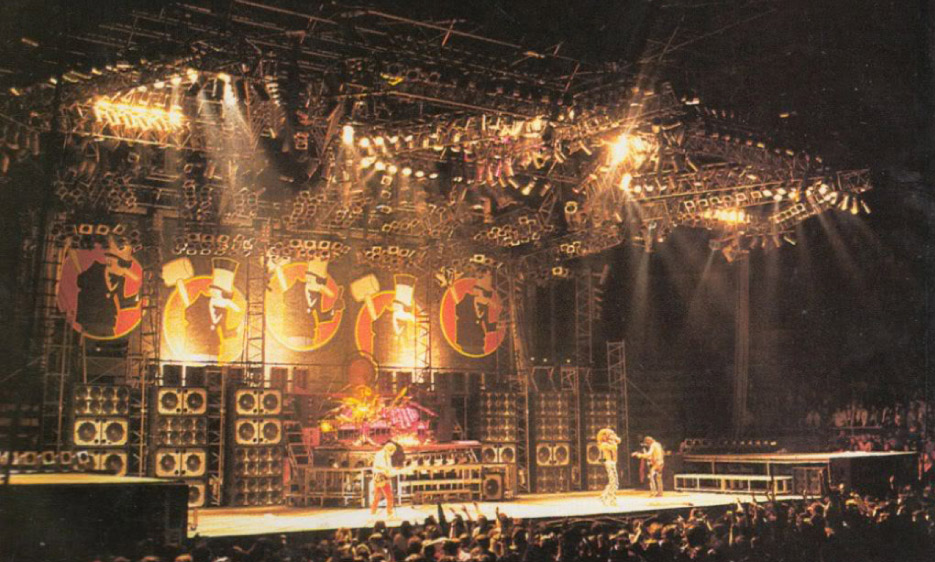 |
|
Above: Light and Sound set up for Van Halen 1984 Live tour. Bonasera was in charge of building the power distribution and the 30 way head set intercom systems for many superstar bands in the 1980s. Below: David Lee Roth tour lighting rig. Besides being an engineering roadie for some of the biggest touring rock shows of the 1980s, Show Lights also rigged for the Academy Awards, the Emmys and the 1984 Olympics in Los Angles (Closing Ceremonies). |
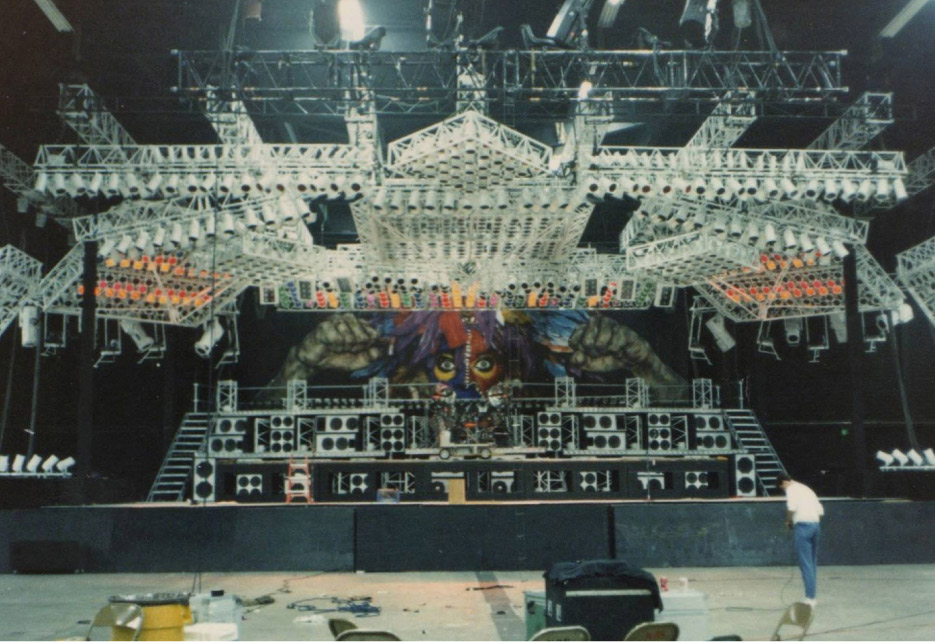 |
|
Below: Two very different venues rigged by Light & Sound. The Rolling Stones 1981 International Tour, Rotterdam Concert, and the 1984 Olympics, Los Angles Stadium. |
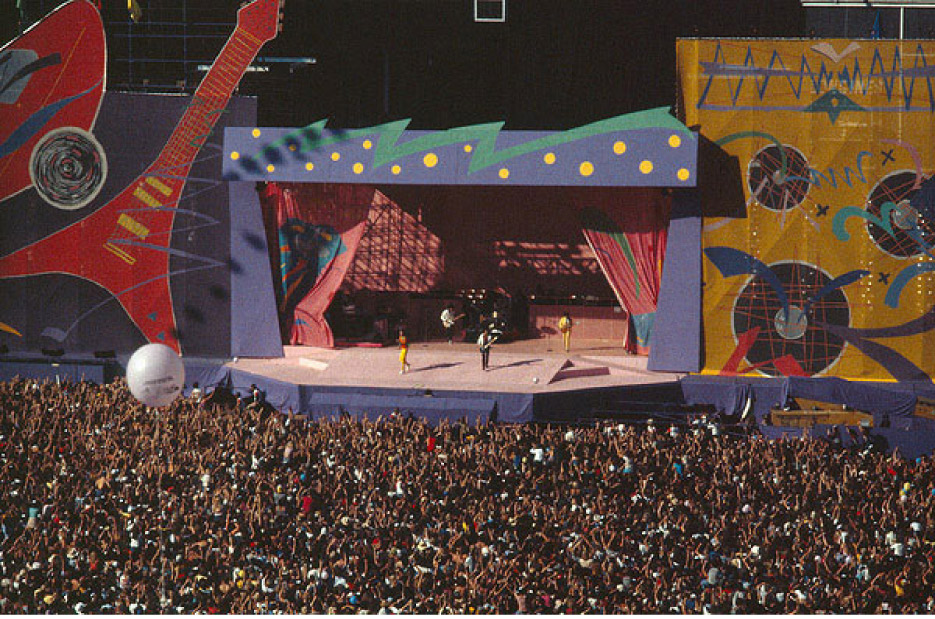 |
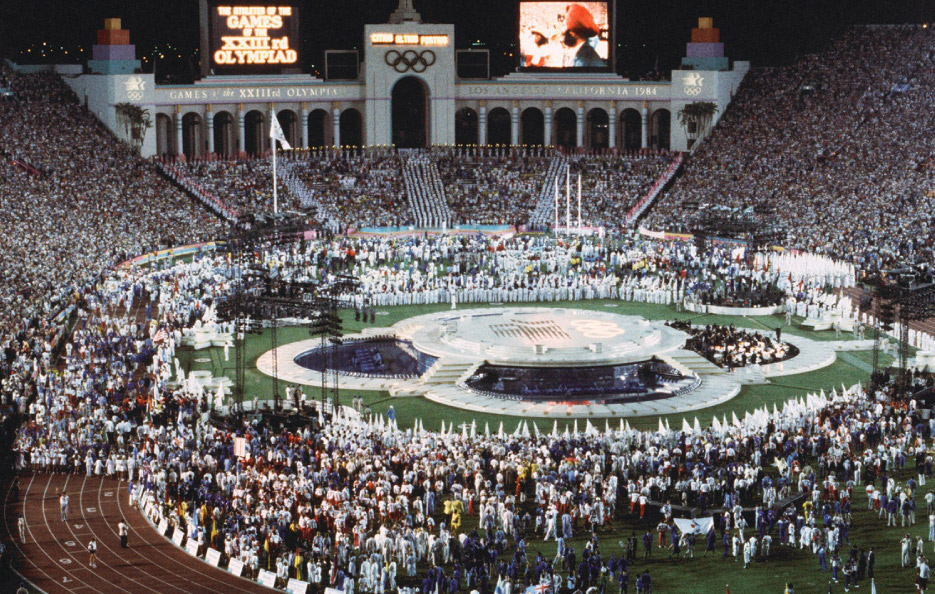 |
A New Beginning
Road and production weary, David’s last tour was with George Clinton and the Funkadelics, and in 1987 created a cleaning business in Los Angeles, California. The company then moved to San Jose a few years later where it quickly morphed into doing restoration, preservation and repairs of natural stone. Currently known as The Marble Guy, David and his crew take on both small and large projects throughout California. David is also an industry educator, consultant and forensics guy who regularly diagnoses problems and specifies remedies.
“Once I got out of rock ‘n’ roll, I wanted to do something different, and started my cleaning company,” Bonasera continued. “From the very beginning, I wanted to use environmentally safe products and procedures to do the work, and named the company ESP, short for Environmentally Safe Products and Procedures.”
About a year later, David met Tim from a company called Multi Seal, who began teaching him how to refinish stone.“Tim didn’t just say, ‘Here’s polish and here’s a pad. Polish this up!’ No, he taught me about the stone itself, and what it can and can’t do, because they all react differently. I take pictures of all my jobs, and none of my guys leave here until they see the pictures, know what they’re walking into, and have all the right grouts, cleaners and sealers, because not one product is going to work on every type of stone. We have products that are made with water and products that are made with oils, and those are two different animals.”
David employs nine very specialized technicians, and went on to say, “These days it’s hard to find the right people. Most of them have been with me for almost two decades. I supply medical, dental and vision benefits, because you want to take care of those who are taking care of you. If you don’t take care of your people, they’ll go somewhere else, and the worst thing you can do is train them to be your competitors. I don’t ever want to do that, because we are usually ahead of our competition as far as methods and technology.”
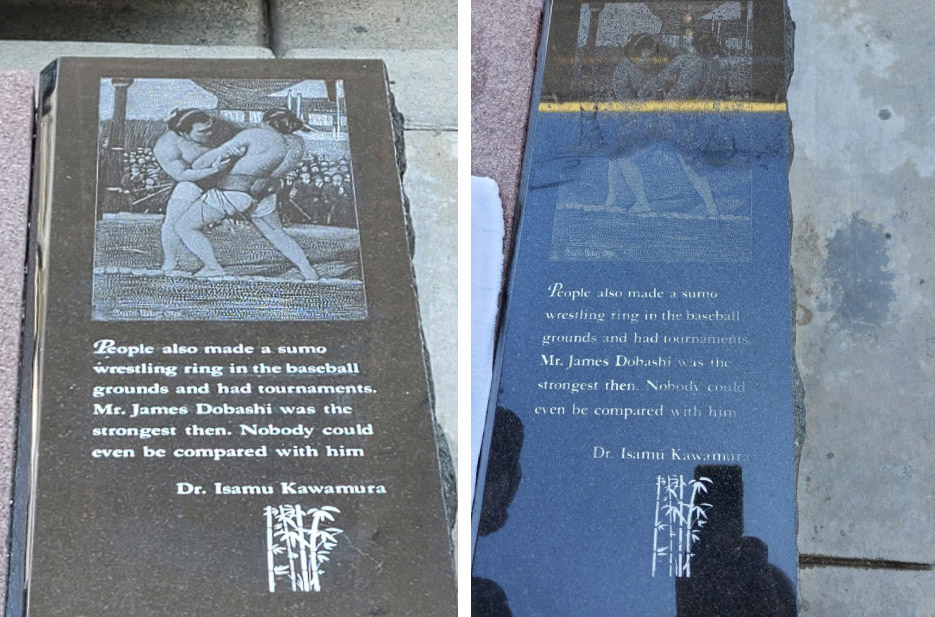 |
|
Before and after process. Dave commented, “This was a test which we did to see if the new 2-part grout epoxy colorant would work on the lettering and the laser-etched picture. Dave: “I had three teams working with three carts on wheels. They were stocked with all of the cleaning solutions: MB-Stone’s Easy Oxy and Stone Pro’s Crystal Clean in a 2-quart sprayer. We used blue doodle bug pads, gallons of rinse water and lots of towels for wiping and buffing out.” Here, Cub Scout team 2 works on a history display. |
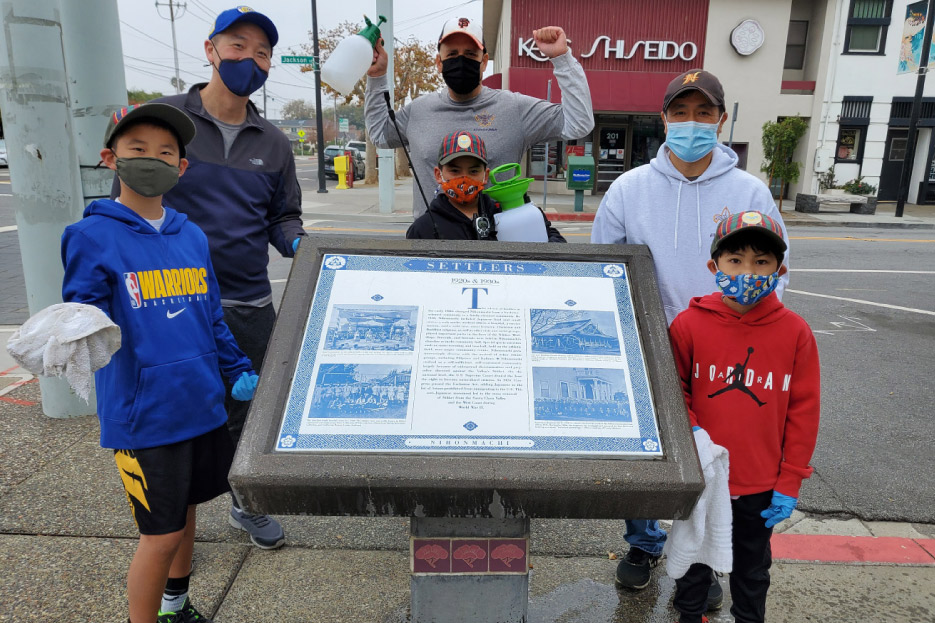 |
| Below: Bonasera demonstrates the cleaning process to the Scouts, and explains the types of stone they are working on, before removing some graffiti |
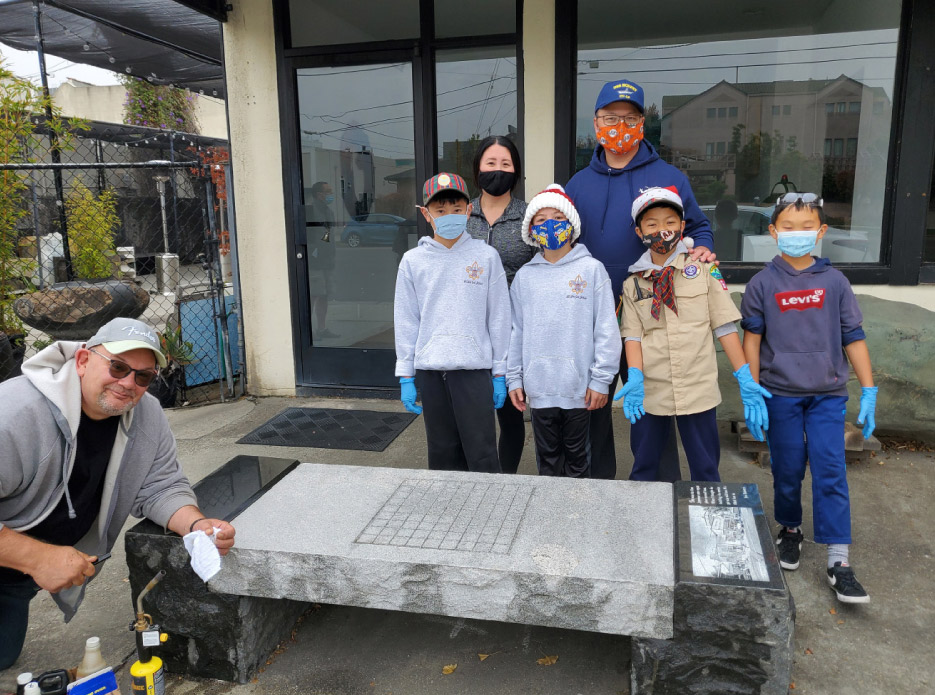 |
|
|
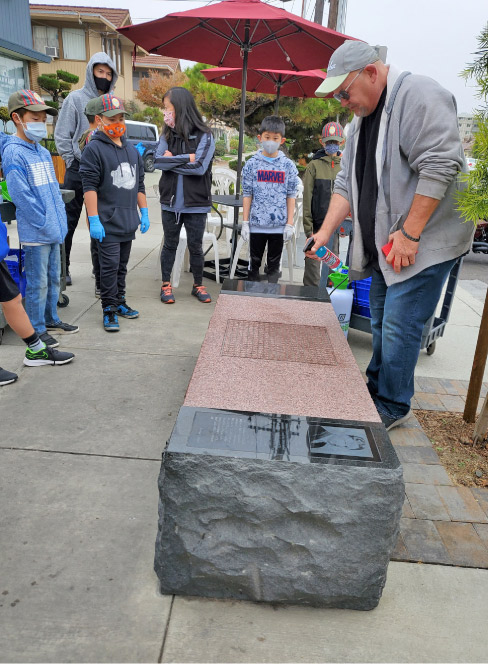 David and Company Take Their Talents and Toolkits to Japantown
David and Company Take Their Talents and Toolkits to Japantown
One of David’s hobbies is the living art of bonsai. For those of you who are unfamiliar with bonsai, the Merriam Webster Dictionary defines it as follows: A potted plant (such as a tree) dwarfed (as by pruning) and trained to an artistic shape. David regularly and vigorously pursues bonsai to the highest degree possible, and considers it to be very therapeutic, he explained.
“My bonsai club is in Japantown in San Jose. I got into it many years ago. It is a good art, a good release and a good hobby. Throughout Japantown, there are black granite benches with laser- etched writing and pictures, that were put in years ago to educate, but they weren’t being kept up. They were weathered and dirty, and since I know stone, I went to one of the elders of Japantown and said, ‘These monuments are getting pretty beat up, and nobody is taking care of them. Would you mind if I bring my crew here, to clean everything up?’”
So David and the crew went in, left a sparkle on a few monuments, and appreciation in the eyes of the onlookers. Needless to say, the elders were grateful, and responded with enthusiasm, he explained.
“We did it the first time, and thereafter, Japantown said they wanted to help and be a part of this. The Japanese are a very proud and very tight knit community, so it was very difficult to get into that world, but once you get their trust, it’s pretty cool. Consequently, we’ve just completed the fourth time we’ve gone back, and we’ve involved the people of Japantown a second, third and fourth time, and just recently the Cub Scouts.
“So the whole thing with this is that I love stone, and I couldn’t stand to see the stones and the meaningful words written on them weathering away, so I took it upon myself to help the community. As a result, the Cub Scouts learned about their history, their parents now understand the stone, and now everyone in Japantown is getting a great education about their past, which goes back to the 1800s, as well as during World War II, when the Japanese were gathered up and put in internment camps. Good or bad, it’s all part of their history, and everybody needs to learn from it. Sometimes it can be very painful, but the way I figured, at a time like now, when everybody is trying to cancel history, it was really important for them to know their past, and why I started working with them to teach them how to preserve it. The kids need to know it, because it makes them better, and if you unselfishly give to them, you’ve created a spark in them, and when they walk away, they’ll run with what they’ve learned. They are amazing!”
Now that the concept of restoration had taken off, and the generations living in Japantown are onboard, the next step is to restore the remaining faded pictures and writing with a newly developed colorant, continued David. “Most of the colorants these days are water-based, and get weathered away when outdoors. So we will be restoring more benches this spring using an epoxy colorant. We’ve got the cleaning down, the education down, and we are going to continue to renew all the landmarks with the help of the Cub Scouts, as well as two young art student ladies within the Japanese community who I’m training to use the colorants on the writing and laser etched pictures. It’s taken a lot of work to organize this, but when it’s done it will be spectacular. It refreshes everything, and it’s good for the community.”
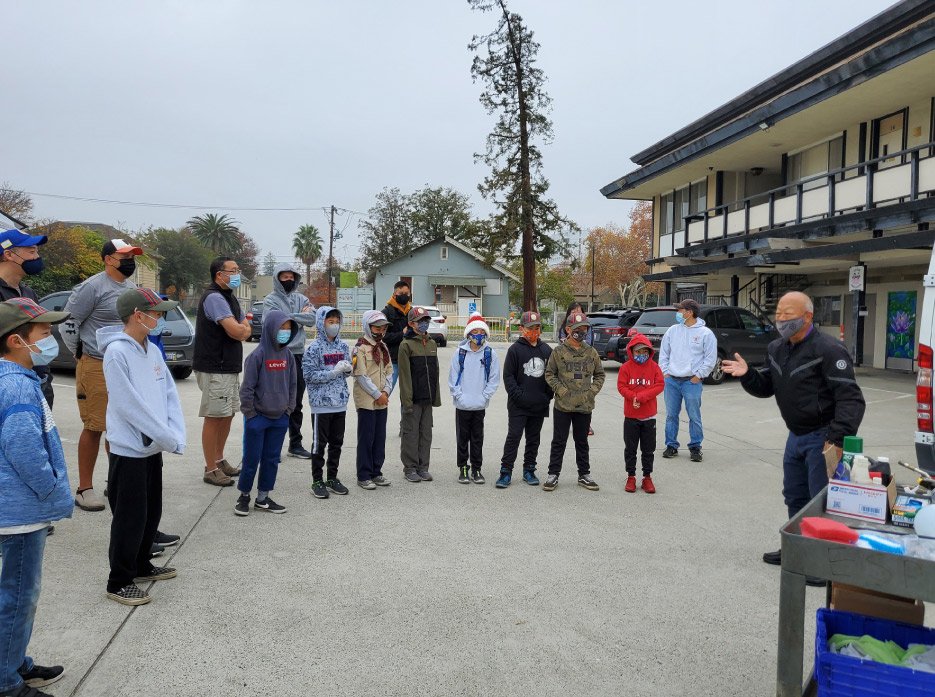 |
|
Above: A retired police officer goes over safety protocols before the volunteer crews spread out to their assigned restoration projects. |
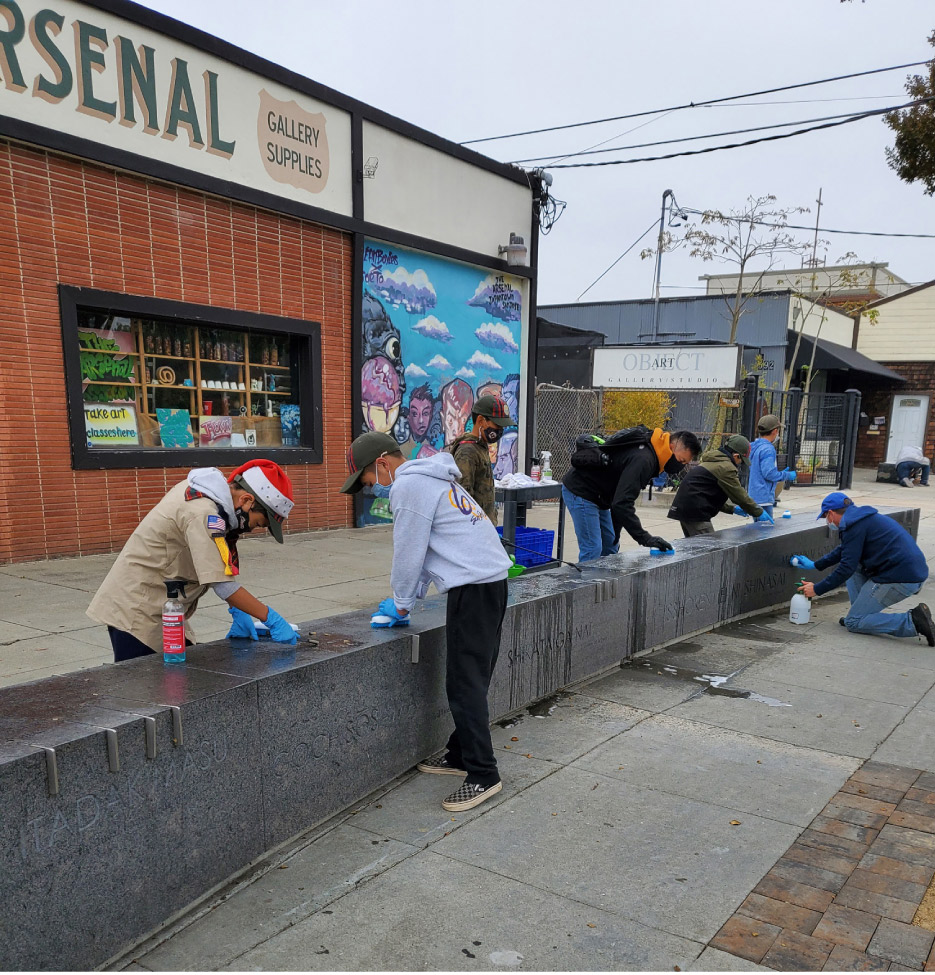 |
|
This flamed Black granite wall pays tribute to Norman Mineta and many others who influenced Japantown over many years, going back to the late 1800s. |
Going Forward in an Ever-Changing Industry
“The stone industry, as far as equipment and technology, is getting more complex as new materials come in. What the industry needs is more focus on natural stone, and how to use it correctly, because if you don’t get the education you need, you’re not going to grow, and the technology will pass you by. There’s enough education out there. There’s just not enough people taking advantage of it. Today, even after 33 years, I still take geology classes. I still have to brush-up on the latest technology, and if I don’t, I’m going to get left behind!
“One of the biggest things that has helped me as a speaker at the Stone Expo, Coverings, and the Surface shows, was to walk each show, talk to the people, learn all the new stuff that’s out there, and take all the educational classes I could. Some people in the industry think they’ve been doing stone for many years, and don’t need any more education! Well... It’s more like they’ve been getting away with it for 30 years, but really don’t know the newer materials.
“Take BB Industries, for instance. Those folks have to know the materials! They have to know what works, where! They do a lot of training and educational stuff, and know what they’re doing, so they can guide their customers on what’s proper to use, as opposed to people who are just selling products out of their truck, and don’t know the products or how they work. A lot of people don’t want to learn. They just want to make the money.
“So unfortunately, I see more problems with (new) fabricators than anyone else. These days, overall, there are fewer fabricators who are doing it right, or who are willing to go back and learn from their mistakes. Today, people don’t want to go back. They just want to go to the next gig, and if there’s a problem, they sometimes don’t take care of the customer. That’s why I’m so busy fixing poorly installed stuff—when I can fix it! I’m a forensics person, and I will guide them on what they did wrong, if they ask. I’ll talk to the insurance companies or the lawyers, and try to help them recover from what went wrong, or specify a complete tear-out, because it wasn’t done correctly.
“There are a lot of people out there, like Fred Hueston, who are doing classes and teaching people forensics. Fred is a smart cat. I’ve known him for a long time, and he knows the mistakes that are out there. He teaches people how to avoid them, because when new products come in and new types of stone come in, everything changes. So one of the best things that people can do in this industry is to get in your car, or get on a plane, and go to a show to learn what’s out there. The ones who make the effort are going to leave smarter and better prepared to do their job.
“You’re never going to stop learning. Working with stone is an art and a craft, so spend the time to keep learning — and that doesn’t mean learning on YouTube!
“If you put in the time, you will get the results. If you just want to cruise, make money, and not do right by your customers, then so be it, but eventually there will be somebody there to bust your chops. It’s your choice.”
A few years ago, David bought Steve’s Polishing Pro Systems, a surface polishing and scratch-removal system–which can still be sourced at BB Industries. This system is designed for the restoration of Engineered Stone / Quartz and man-made countertop material, and is designed with different polishing compounds and pads than used for granite. Like many polishing systems, training is crucial to get the best results in removing surface scratches.
David Bonasera has been an educational speaker at major shows for seventeen years. In 2022 he is scheduled to give three educational classes on a variety of subjects concerning natural stone. Anyone interested in attending these classes or for information regarding his services or Better Bio Solutions® products, contact Bonasera at www.davethemarbleguy.com or call 408-436-0470.
